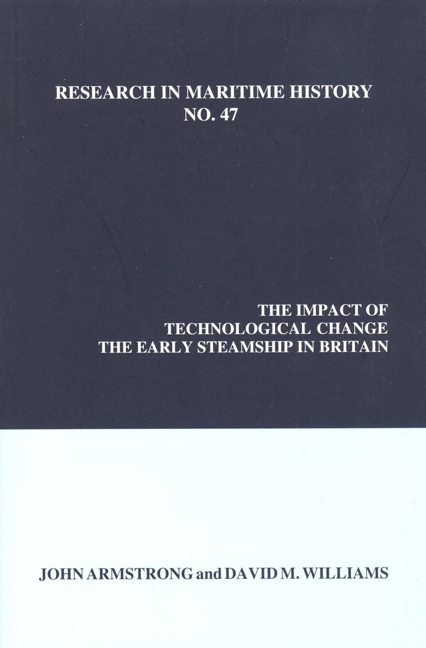Book contents
- Frontmatter
- Contents
- Series Editor's Foreword
- About the Authors
- Introduction
- Chapter 1 British Steam Navigation, 1812 to the 1850s: A Bibliographical and Historiographical Review
- Chapter 2 Some Official Listings of “Vessels Navigated by Steam” in Britain up to 1851: Evidence and Interpretation
- Chapter 3 The Steamboat, Safety and the State: Government Reaction to New Technology in a Period of Laissez-Faire
- Chapter 4 The Steamboat and Popular Tourism
- Chapter 5 The Thames and Recreation, 1815-1840
- Chapter 6 Steam Shipping and the Beginnings of Overseas Tourism: British Travel to North Western Europe, 1820-1850
- Chapter 7 Technological Advance and Innovation: The Diffusion of the Early Steamship in the United Kingdom, 1812-1834
- Chapter 8 The Steamship as an Agent of Modernisation, 1812-1840
- Chapter 9 “A New and Very Modern Business:” The Traffic and Operations of the Early Steamship
- Chapter 10 Promotion, Speculation and Their Outcome: The “Steamship Mania” of 1824-1825
- Chapter 11 The Perception and Understanding of New Technology: A Failed Attempt to Establish Transatlantic Steamship Liner Services, 1824-1828
- Chapter 12 The “Norwich Explosion” of 1817: A Local Tragedy of National Significance
- Chapter 13 Early Steamboat Services and Their Impact in North Wales, 1817-1840s
- Chapter 14 The Beginnings of a New Technology: The Constructors of Early Steamboats, 1812-1822
Introduction
- Frontmatter
- Contents
- Series Editor's Foreword
- About the Authors
- Introduction
- Chapter 1 British Steam Navigation, 1812 to the 1850s: A Bibliographical and Historiographical Review
- Chapter 2 Some Official Listings of “Vessels Navigated by Steam” in Britain up to 1851: Evidence and Interpretation
- Chapter 3 The Steamboat, Safety and the State: Government Reaction to New Technology in a Period of Laissez-Faire
- Chapter 4 The Steamboat and Popular Tourism
- Chapter 5 The Thames and Recreation, 1815-1840
- Chapter 6 Steam Shipping and the Beginnings of Overseas Tourism: British Travel to North Western Europe, 1820-1850
- Chapter 7 Technological Advance and Innovation: The Diffusion of the Early Steamship in the United Kingdom, 1812-1834
- Chapter 8 The Steamship as an Agent of Modernisation, 1812-1840
- Chapter 9 “A New and Very Modern Business:” The Traffic and Operations of the Early Steamship
- Chapter 10 Promotion, Speculation and Their Outcome: The “Steamship Mania” of 1824-1825
- Chapter 11 The Perception and Understanding of New Technology: A Failed Attempt to Establish Transatlantic Steamship Liner Services, 1824-1828
- Chapter 12 The “Norwich Explosion” of 1817: A Local Tragedy of National Significance
- Chapter 13 Early Steamboat Services and Their Impact in North Wales, 1817-1840s
- Chapter 14 The Beginnings of a New Technology: The Constructors of Early Steamboats, 1812-1822
Summary
The coming of the steamship was one of the great watersheds in the history of humankind. For the first time, transport could be powered independently of the elements of animal or human power. The implications were wide-ranging because the assured power of steam permitted a hitherto unprecedented degree of regularity in the scheduling of services. In turn, this regularized all sorts of commercial transactions, including personal travel, and impinged on the experience of vast swathes of the population through a new discipline of time and a broadening of horizons as the new mode of transport shortened distance and permitted the more rapid transport of goods, people and information. The lives of individuals and institutions were transformed by the coming of the steamship, first at a local level, but within decades of the first commercial voyages at regional, national, international and world levels. The steamship was the prime agent of a world economy and the globalization process. Moreover, the transformation wrought by the steamship took place in less than a century.
Experiments with steam as a means of powering water transport had a long history, but it was during the years around 1810 that the first commercial exploitation began. The United States was the pioneer, with Britain following closely behind. The experiences of these two nations in steam navigation soon diverged; for geographical, political and economic reasons, progress in terms of a diversity of function and an international dimension was more rapid in Britain. The essays in this volume are set in the first forty years or so of the steamship's existence in Britain. They cover a variety of themes, notably diffusion, construction, modernization, government, business, finance, recreation and tourism.
At the outset we must gratefully acknowledge the support we have received in assembling this volume. Eleven of the fourteen essays included have been previously published. They appear in this new setting entirely through the good will and permission of the editors and proprietors of ten important academic journals. These, in the order in which the relevant papers appear, in this volume are Mariner's Mirror, Journal of Transport History, London Journal, Journal of European Economic History, International Journal of Maritime History, Aslib Proceedings, The Northern Mariner/Le marin du nord, Norfolk Archaeology, Maritime Wales/Cymru a'r Mor, and International Journal for the History of Engineering and Technology.
- Type
- Chapter
- Information
- The Impact of Technological ChangeThe Early Steamship In Britain, pp. 1 - 6Publisher: Liverpool University PressPrint publication year: 2011



